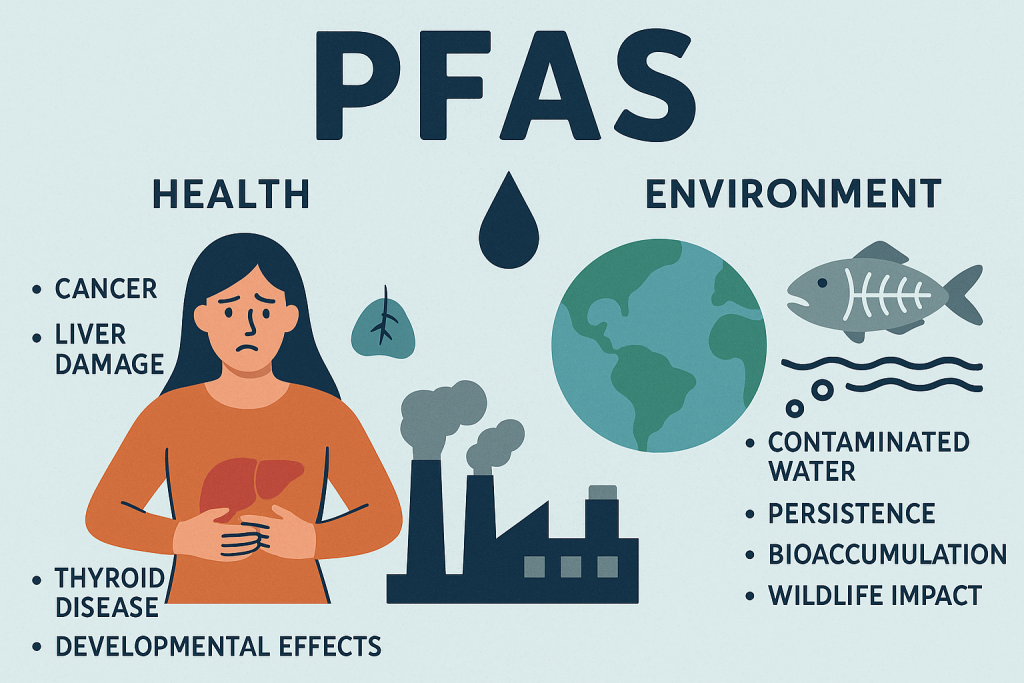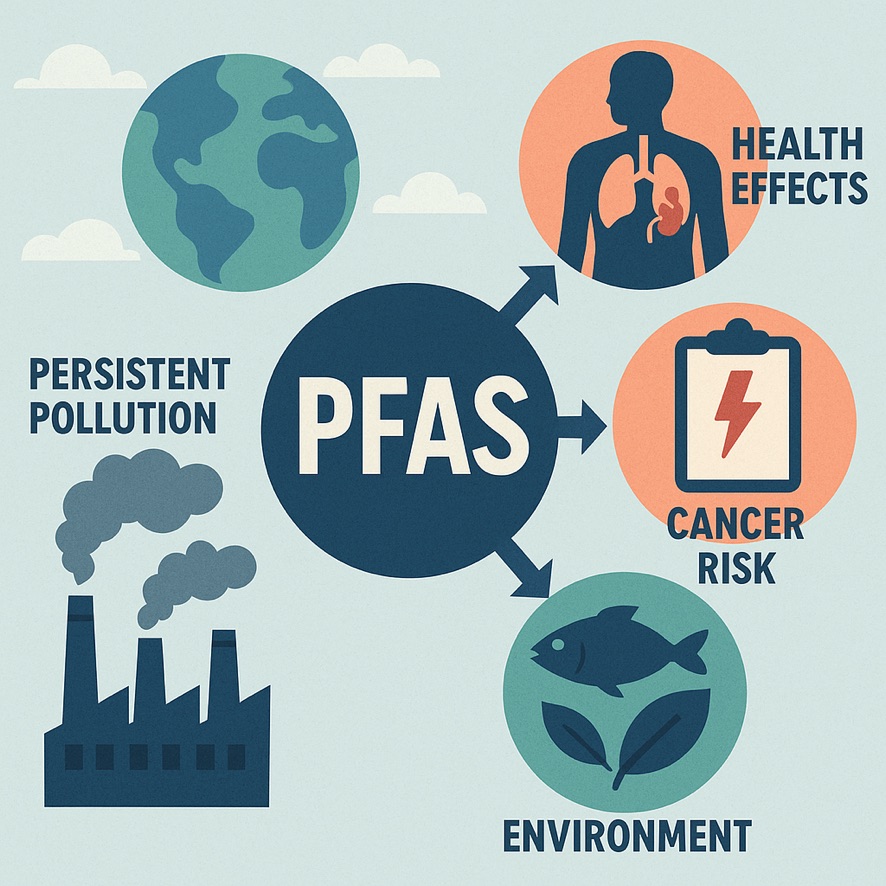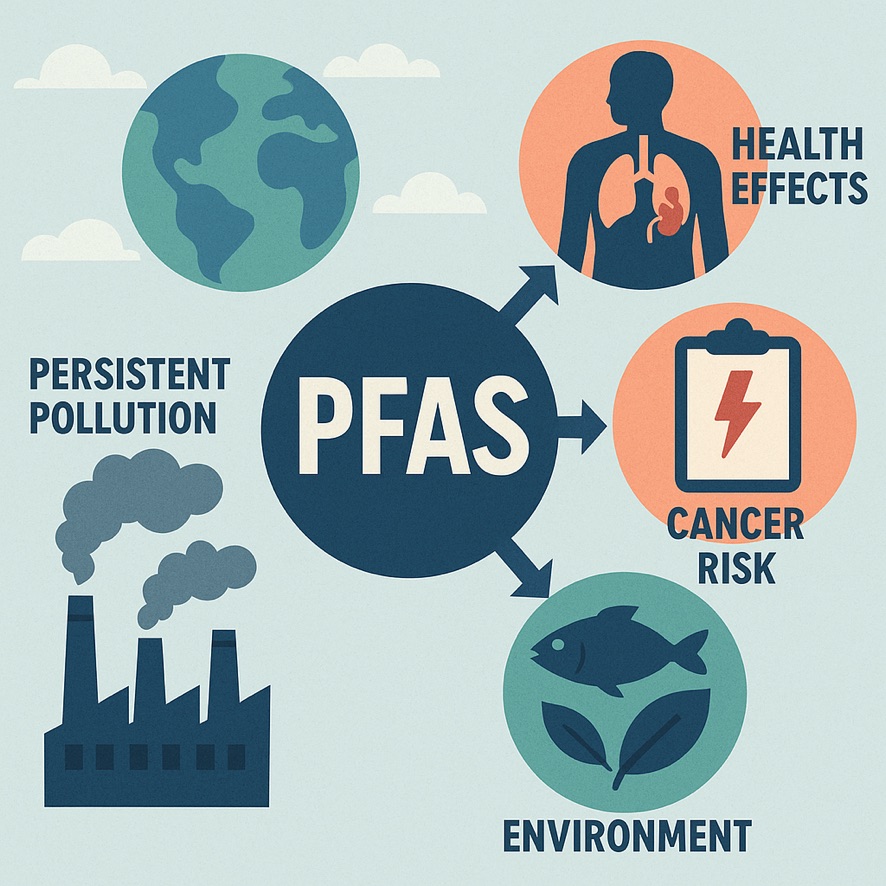DEADLY PFAS
What Are PFAS?
Per- and polyfluoroalkyl substances (PFAS) are a class of over 15,000 synthetic chemicals characterized by their strong carbon-fluorine bonds, making them highly resistant to heat, water, oil, and degradation. This group of synthetic chemicals has used in industrial and consumer products since the 1940s. Often called “forever chemicals” because they do not break down naturally in the environment, PFAS have been found in water, soil, air, and even human blood. Their resistance to heat, water, and oil made them popular in non-stick cookware, waterproof clothing, food packaging, and firefighting foam. However, their persistence has led to widespread contamination and serious health risks.
Common Types of PFAS
- PFOA (Perfluorooctanoic Acid) – Used in Teflon non-stick coatings.
- PFOS (Perfluorooctanesulfonic Acid) – Found in Scotchgard and firefighting foam.
- GenX Chemicals – Developed as a “safer” replacement but still hazardous.
- PFHxS, PFNA, and others – Used in food packaging, waterproof fabrics, and industrial processes.
History of PFAS: From Innovation to Crisis
PFAS were first developed in the late 1930s by chemists at DuPont and later by 3M. The most well-known PFAS compounds are PFOA (perfluorooctanoic acid) and PFOS (perfluorooctanesulfonic acid), used in Teflon non-stick pans and Scotchgard stain repellents.
By the 1960s, internal studies at these companies revealed that PFAS were toxic to animals and possibly humans, but this information was not made public for decades. In the early 2000s, lawsuits and environmental investigations exposed the dangers of PFAS, particularly in communities near manufacturing plants where drinking water was heavily contaminated.
Despite phased-out production of PFOA and PFOS in the U.S., thousands of other PFAS chemicals remain in use, and legacy contamination persists worldwide.
1940s–1950s: The Birth of “Miracle” Chemicals
- 1946: DuPont introduces Teflon, a non-stick coating for cookware, using PFOA.
- 1950s: 3M develops PFOS-based Scotchgard for stain-resistant fabrics and carpets.
- Early military and industrial applications include firefighting foams (AFFF) used at airports and military bases.
1960s–1980s: Early Warnings Ignored
- 1961: Internal DuPont studies show PFOA causes liver enlargement in rats.
- 1970s: 3M and DuPont discover PFAS in workers’ blood but suppress findings.
- 1980s: Studies link PFAS to birth defects in plant workers’ children, but companies continue production.
1990s–2000s: Legal Battles and Public Outcry
- 1998: A farmer sues DuPont after cattle die from PFOA-contaminated water in Parkersburg, West Virginia.
- 2001: Investigations reveal PFAS in public water supplies, leading to EPA scrutiny.
- 2006: Major U.S. manufacturers phase out PFOA and PFOS under pressure—but replace them with equally problematic alternatives (e.g., GenX).
2010s–Present: A Growing Global Crisis
- 2016: EPA sets a non-enforceable health advisory limit for PFAS in drinking water.
- 2022: EPA declares PFOA and PFOS hazardous substances and proposes strict limits.
- 2023–2024: Thousands of lawsuits target chemical companies, with settlements reaching billions of dollars for water cleanup.
Health Effects: How PFAS Harm the Human Body
PFAS accumulate in blood, liver, and kidneys, disrupting biological processes. Key health risks include:
1. Cancer
- Kidney, testicular, thyroid, and liver cancers linked to long-term exposure.
- The International Agency for Research on Cancer (IARC) classifies PFOA as possibly carcinogenic.
2. Reproductive and Developmental Harm
- Reduced fertility in men and women.
- Low birth weight, developmental delays, and weakened immune systems in children.
3. Immune System Suppression
- Reduced antibody response to vaccines (e.g., tetanus, COVID-19).
- Increased susceptibility to infections.
4. Metabolic and Organ Damage
- Elevated cholesterol levels (even in young, healthy individuals).
- Liver disease and hormone disruption (thyroid dysfunction).

Environmental Impact: A Persistent Threat
PFAS contamination is global. Because PFAS do not degrade, they accumulate in the environment and the human body. They have been detected in:
- Rainwater (even in remote areas like Antarctica).
- Wildlife (fish, dolphins, polar bears with dangerous bioaccumulation).
- Farmland (via sewage sludge used as fertilizer).
- Drinking water (millions of Americans are exposed through contaminated supplies)
- Food (via packaging, contaminated soil, and fish from polluted waters)
- Household dust (from carpets, furniture, and clothing treated with PFAS)
- Breast milk, indicating that mothers can pass these chemicals to infants
Notable Contamination Sites
- Parkersburg, WV (DuPont dumping) – Led to a $670M class-action settlement.
- Cape Fear River, NC (Chemours/GenX pollution) – Affected 300,000+ residents.
- Military bases nationwide – Firefighting foam has poisoned groundwater.
How to Avoid PFAS: Practical Steps for Daily Life
1. Water Filtration
- Best option: Reverse osmosis (RO) filters (removes ~90% of PFAS).
- Second best: Activated carbon filters (pitcher or under-sink systems).
- Avoid: Boiling water (does not destroy PFAS; may concentrate it).
2. PFAS-Free Kitchen Choices
- Replace non-stick pans with cast iron, stainless steel, or ceramic cookware.
- Avoid grease-proof food packaging (microwave popcorn, fast-food wrappers).
- Use glass or stainless steel containers instead of plastic.
3. Safer Household Products
- Check labels for “PFAS-free” on:
- Carpets & furniture (avoid “stain-resistant” treatments).
- Waterproof clothing (look for brands like Patagonia, which phased out PFAS).
- Vacuum with HEPA filters to reduce dust exposure.
4. Dietary Adjustments
- Limit consumption of contaminated fish (check local advisories).
- Choose organic and unpackaged foods when possible.
Systemic Solutions: Policy, Innovation, and Accountability
1. Stronger Regulations
- U.S. EPA’s 2024 PFAS Drinking Water Standard sets limits at 4 parts per trillion (among the strictest in the world).
- EU’s proposed ban on all PFAS by 2025–2030.
2. Corporate Accountability
- 3M agreed to pay $10.3B to settle water contamination lawsuits (2023).
- DuPont/Chemours settlements fund cleanup and health monitoring.
3. Scientific Breakthroughs
- Destruction technologies (supercritical water oxidation, plasma reactors).
- Bio-based alternatives (plant-derived water repellents).
A Call to Action
PFAS contamination is one of the most pressing environmental health crises of our time. While individual actions help, systemic change is essential. Support:
- Stricter chemical regulations (follow organizations like EWG or NRDC).
- Clean water advocacy (demand municipal PFAS testing).
- Sustainable corporations (reward brands that eliminate PFAS).
The age of “forever chemicals” must end—through science, policy, and collective action, we can protect future generations.
PFAS-Free Product Guide & Advocacy Toolkit
Part 1: Trusted PFAS-Free Brands
Cookware & Kitchen Essentials
✅ Non-Toxic Pans:
- Caraway (ceramic non-stick)
- GreenPan (thermolon ceramic coating)
- Lodge (cast iron)
- All-Clad (stainless steel)
✅ Food Storage:
- Pyrex (glass containers)
- Stasher (silicone bags)
- Bee’s Wrap (beeswax food wraps)
Waterproof & Stain-Resistant Gear
✅ Apparel & Footwear:
- Patagonia (PFAS-free DWR treatments)
- Columbia (Omni-Tech Eco waterproofing)
- KEEN (PFAS-free boots)
✅ Outdoor Gear:
- Fjällräven (Greenland Wax instead of PFAS)
- REI Co-op (many PFAS-free rain jackets)
Home & Furniture
✅ Carpets & Rugs:
- Earth Weave (wool, natural fibers)
- FLOR (modular PFAS-free carpet tiles)
✅ Furniture & Bedding:
- Avocado (organic mattresses, no flame retardants)
- Coyuchi (organic cotton, PFAS-free waterproof bedding)
Personal Care & Cosmetics
✅ Makeup & Skincare:
- Credo Beauty (strict PFAS-free policy)
- Ilia Beauty (clean makeup)
- Biossance (PFAS-free skincare)
✅ Dental Floss:
- Dental Lace (silk floss, PFAS-free)
- TreeBird (plant-based floss)
Part 2: How to Advocate for PFAS Regulation
1. Stay Informed
📌 Key Organizations Tracking PFAS:
- Environmental Working Group (EWG) – PFAS contamination maps & policy updates.
- NRDC (Natural Resources Defense Council) – Legal actions & advocacy.
- Safer States – Tracks state-level PFAS bans.
2. Take Action Locally
🔹 Test Your Water:
- Request a PFAS water test from your utility (EPA’s new 4 ppt rule helps).
- If levels are high, demand municipal filtration upgrades.
🔹 Push for Bans:
- Support state laws banning PFAS in food packaging, textiles, and cosmetics.
- Example successes:
- Maine (broad PFAS ban by 2030)
- California (PFAS bans in apparel, cosmetics)
3. Demand Corporate Accountability
✉️ Contact Companies:
- Ask brands, “Do you test for PFAS in your products?”
- Pressure fast-food chains (McDonald’s, Wendy’s) to drop PFAS-laden packaging.
💡 Vote with Your Wallet:
- Support B Corp brands (they’re more likely to avoid PFAS).
4. Federal Policy Advocacy
📢 Contact Lawmakers:
- Push for the PFAS Action Act (comprehensive U.S. regulation).
- Urge the EPA to regulate all PFAS as a class, not individually.
Part 3: The Future of PFAS Solutions
Scientific Innovations
🔬 Breakthrough Cleanup Tech:
- Supercritical water oxidation (destroys PFAS at high heat/pressure).
- Plasma reactors (breaks PFAS bonds with electricity).
🌱 Safer Alternatives:
- Plant-based water repellents (e.g., PFOA-free wax coatings).
- Biosurfactants (natural stain-resistant treatments).
What’s Next?
- 2025–2030: Expect more global bans (EU leading the way).
- Ongoing lawsuits will force more companies to phase out PFAS.
Final Thoughts
Avoiding PFAS completely is hard, but every small step helps. By choosing safer products, filtering water, and demanding change, we can reduce exposure and push for a PFAS-free future.
Want more? Check out:
PFAS Central (updated brand commitments)
EWG’s Skin Deep Database (PFAS-free cosmetics)






This post is interesting and intriguing. PFAS, chemicals so persistent that they’ve been found in rainwater on every continent, including Antarctica. What’s most alarming is how they bioaccumulate: studies now detect PFAS in 99% of Americans’ blood, with prenatal exposure linked to low birth weights and immune dysfunction.
The corporate parallels to Big Tobacco are chilling. For decades, manufacturers like 3M and DuPont concealed internal research showing harm while lobbying against regulation. Even today, many ‘replacement’ PFAS (like GenX) may be just as hazardous.
Real solutions require:
Strict class-based bans (not just PFOA/PFOS)
Polluter-funded cleanup (3M’s $10B settlement is a start)
Advanced filtration in water systems (reverse osmosis is key)
DIFER.org’s site is vital especially on ‘greenwashing’ by chemical companies. How can we pressure retailers to phase out PFAS in food packaging and textiles faster?
Forever chemicals like PFAS are truly alarming! They don’t break down, they bioaccumulate in our bodies, and they’re linked to serious health risks like cancer, thyroid disease, and immune system harm. What’s even more concerning is how widespread they are: in non-stick cookware, waterproof clothing, food packaging, and even drinking water. People really need to be informed about their DANGERS! We don’t even know all the harm they can cause, because companies like DUPONT and 3M stopped research about them when they realized how bad the really could be. We need to hold companies responsible! They knew what they were producing was terrible for every living thing! There was a great APPLE New Podcast about this very topic and the movie was good too. THANK YOU DIFER FOR TRYING TO MAKE A DIFFERENCE!
Thank you for your comment, Katie! You’re absolutely right—PFAS contamination is one of the most insidious environmental health crises we face. The fact that these chemicals persist indefinitely in our bodies and ecosystems, combined with the evidence of corporate cover-ups (like DuPont and 3M suppressing research), is infuriating. It’s a stark reminder of why transparency and accountability in the chemical industry are so critical.
I appreciate you mentioning the podcast and film (The Devil We Know and Dark Waters are eye-opening!). For anyone wanting to learn more, I’d also recommend the EPA’s recent PFAS Strategic Roadmap and NGOs like the Environmental Working Group (EWG), which track contamination sites and push for stricter regulations.
The good news is that public pressure IS working: some states are banning PFAS in food packaging and firefighting foam, and safer alternatives are emerging. But as you said, individual action matters too—avoiding non-essential water-resistant sprays, filtering drinking water, and supporting policies that hold polluters financially responsible for cleanup.
What change would you most like to see—stronger legislation, better consumer labeling, or something else? Thanks for raising your voice on this!
A powerful and eye-opening read. The long-lasting impact of PFAS is alarming, but it’s encouraging to see growing awareness and steps we can take to protect our health and the environment. Time for stronger regulations and smarter choices! 🌍💧
This is why I support sustainable brands. PFAS are a hidden danger, and this post does an excellent job exposing the problem. More people need to see this!
This is such an important and eye-opening read. PFAS contamination is a silent crisis affecting so many aspects of our lives from drinking water to food packaging, yet many people still aren’t aware of the risks. I appreciate how this post not only highlights the dangers but also offers practical steps we can take to reduce exposure and advocate for change.
Have there been any recent policy developments or breakthroughs in PFAS filtration technology? And for those looking to take action, are there specific organizations you’d recommend supporting in the fight against these “forever chemicals”?
Thanks for shedding light on this critical issue. More awareness is the first step toward meaningful change!
Thank you so much for your insightful comment!I’m thrilled this resonated with you! You’re absolutely right: PFAS contamination is a hidden crisis with far-reaching consequences, and public awareness is crucial to driving action.
To answer your questions:
1️⃣ Policy Progress: The EPA recently finalized strict limits on PFAS in drinking water (as of April 2024), and states like Maine and California are leading bans on PFAS in consumer products. Internationally, the EU is also tightening regulations—momentum is growing!
2️⃣ Tech Breakthroughs: Researchers are developing advanced filtration methods (like boron nitride “nanotubes” and improved carbon filters), while companies like Aquagga are pioneering PFAS-destruction tech. Exciting, but scaling remains a challenge.
3️⃣ Take Action: Fantastic orgs like EWG (Environmental Working Group), Clean Water Action, and PFAS Central (by Green Science Policy Institute) offer advocacy toolkits, testing resources, and campaigns to join.
Keep spreading the word—change starts with voices like yours! Let me know if you’d like deeper dives on any of these. Grateful for your engagement! 🌍✨
Forever chemicals are everywhere, and this article explains the risks clearly. Time to rethink our products and push for stricter regulations!
A must-read! This post breaks down the scary truth about PFAS in a way that’s easy to understand. We need more awareness and action on this issue! Thanks for spreading the word, DIFER.org!